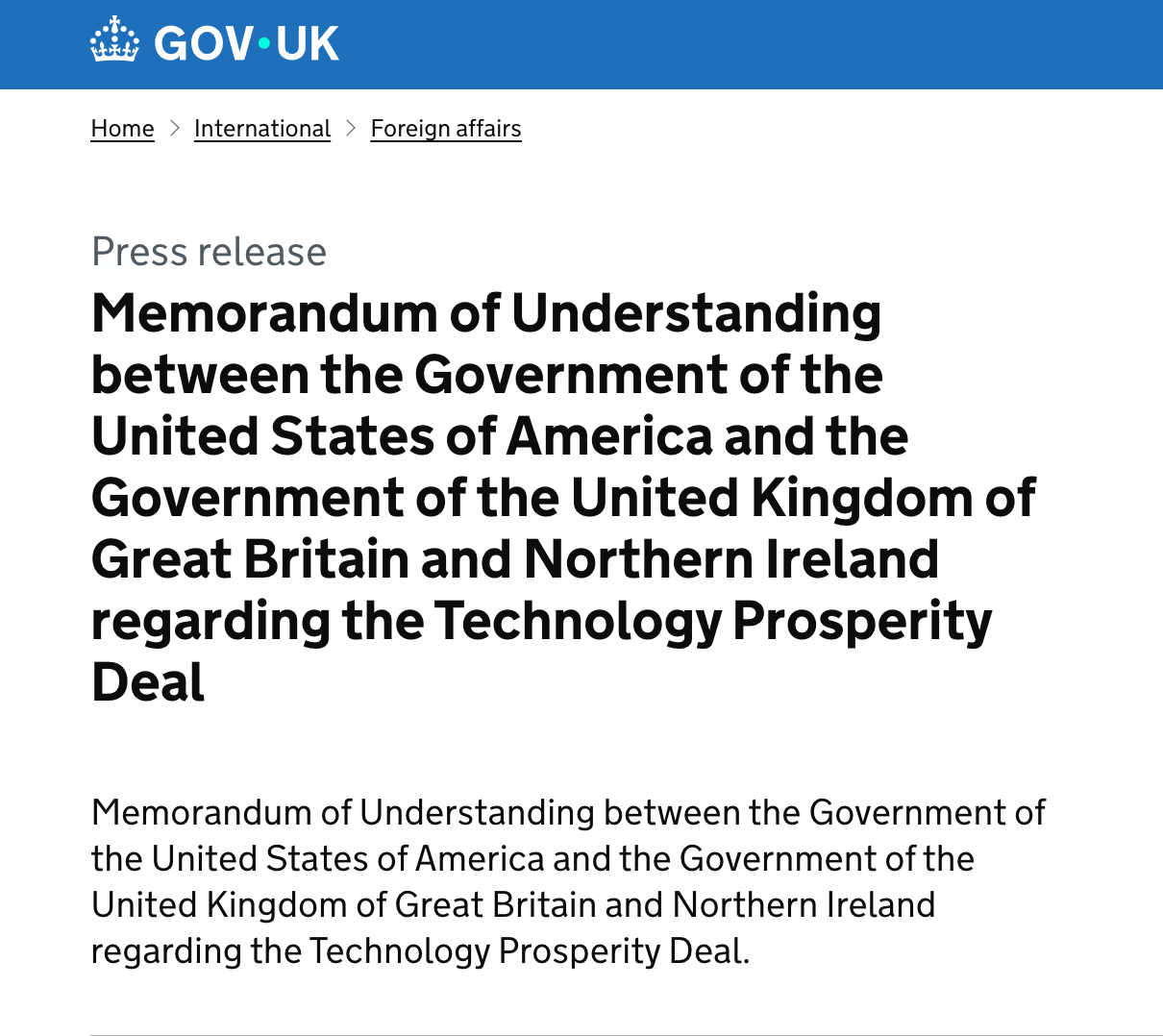Policy Update: A Deal on Tech or a Play for Power?
The US and UK signed the Technology Prosperity Deal to collaborate on AI, nuclear, and quantum technologies.
International cooperation in science and technology is rarely as straightforward. The Technology Prosperity Deal between the United States and the United Kingdom is framed as a landmark agreement, yet its ambitions expose unresolved questions of governance, accountability, and national interest.
The Technology Prosperity Deal: A New Era of US–UK Cooperation
On 18 September 2025, the governments of the United States and the United Kingdom signed a Memorandum of Understanding establishing what is called the Technology Prosperity Deal.
This agreement represents a structured partnership to deepen cooperation in science and technology.
It builds on a long history of collaboration between the two countries and sets out a framework for cooperation in areas such as artificial intelligence, nuclear technologies, and quantum research.
The deal involves creating tangible outcomes for citizens by aligning legal, regulatory, and research structures.
It also ensures that both countries remain influential leaders in the development of science and technology in ways that safeguard values of security, prosperity, and innovation.
Artificial Intelligence
Artificial intelligence is given priority attention within the agreement.
Both governments have committed to expanding access to compute infrastructure, supporting the development of shared datasets, and establishing flagship research programs in AI-enabled science.
These will cover areas such as biotechnology, cancer research, rare and chronic diseases, and energy research including fusion.
The agreement establishes a pathway for U.S. and UK research institutions, such as the Department of Energy, the National Science Foundation, and the UK Research and Innovation body, to coordinate joint funding, joint use of compute resources, and collaboration on new AI models.
There will be efforts to advance automated laboratory technologies, expand opportunities for joint research, and strengthen AI applications in space exploration through links between NASA and the UK Space Agency.
An important institutional link is also planned between the U.S. Center for AI Standards and Innovation and the UK AI Security Institute.
Their cooperation will include joint work on standards, research into advanced AI capabilities, and talent exchanges.
This is intended to establish a framework for trusted AI adoption while also supporting industry export opportunities, particularly in semiconductors, data centers, and models.
For citizens and businesses, this offers the possibility of more collaborative projects, greater employment opportunities in AI-related roles, and access to stronger infrastructure supporting scientific advancement.
Civil Nuclear Energy
The memorandum also recognises nuclear technologies as central to the future of energy, security, and industrial competitiveness.
The governments of the United States and the United Kingdom aim to accelerate development in advanced nuclear reactors and fuels, ensure secure supply chains, and establish independence from Russian nuclear fuel by the end of 2028.
The document is explicit about improving regulatory timelines, with targets such as completing reactor design reviews within two years and site licensing within one year.
The aim is to give industry greater certainty while ensuring high standards of safety, security, and non-proliferation.
Collaboration will also extend into fusion energy research. Both countries have committed to pursuing harmonised policy and regulation to support a global market for fusion energy led by the United States and the United Kingdom.
The memorandum also leaves open possibilities for civil maritime nuclear applications and for nuclear-powered resilience in defence facilities.
These provisions are not abstract; they mean practical efforts to reduce costs, accelerate projects, and strengthen energy resilience for both societies.
Quantum Technologies
The agreement addresses quantum technologies as a central frontier in science and innovation.
The text identifies cooperation in quantum information science, quantum computing, and secure quantum communications.
It commits to supporting collaborative research, developing standards, and encouraging workforce development.
Although the memorandum does not prescribe detailed technical objectives, it provides a basis for cross-governmental and cross-agency partnerships.
This creates the foundation for long-term leadership in quantum research and for coordinated policy frameworks that can support adoption by businesses and research institutions.
Strategic Importance
The memorandum emphasises that the United States and the United Kingdom share deep-rooted expertise, strong security partnerships, and complementary regulatory regimes.
By agreeing to this structured partnership, both governments are positioning themselves to influence global standards, develop joint responses to strategic challenges, and support domestic industries in highly technical fields.
For the general public, the implications are clear. Access to new energy technologies, new medical applications of AI, and more resilient infrastructure are not distant policy concepts but elements that can affect jobs, healthcare, and national security in direct ways.
The memorandum offers opportunities to participate in collaborative projects, benefit from streamlined regulatory processes, and enter export markets supported by joint government frameworks.
Why This Matters
The Technology Prosperity Deal shows that governments are prepared to create structured and ambitious frameworks for science and technology cooperation.
It signals that innovation is not only about industry leadership but also about government-led coordination, standards, and infrastructure.
Practical measures such as joint funding, shared access to compute, regulatory streamlining, and supply chain security will directly influence how technologies develop over the next decade.
Individuals who are part of research communities, industry associations, or educational institutions should be aware of the opportunities to engage with collaborative projects supported by this deal.
Businesses involved in nuclear, AI, or quantum sectors should pay attention to the new export and regulatory provisions that may open doors for participation.
This memorandum of understanding is a reminder that science and technology progress most effectively when supported by structured international partnerships.
The United States and the United Kingdom have chosen to formalise their cooperation with clarity on purpose, scope, and timelines.
Citizens, businesses, and institutions in both countries should be attentive to the opportunities and responsibilities that follow.
The Technology Prosperity Deal is a practical document with clear commitments.
It represents a deliberate effort to coordinate resources, policies, and expertise in order to deliver benefits for people in both countries and to support leadership in technologies that will define the coming decades.
The Deal in Perspective
The Deal between the United States and the United Kingdom is presented as a landmark framework for cooperation on artificial intelligence, nuclear energy, and quantum technologies.
Yet the memorandum offers more political symbolism than substantive detail.
The text highlights ambitions such as accelerated nuclear licensing timelines, joint AI research programs, and secure supply chains, but it avoids addressing deeper questions of accountability, governance, and the distribution of benefits.
In nuclear energy, the proposed two year reactor review and one year site licensing targets may satisfy industry demand for certainty, but they risk compromising the independence of regulatory oversight.
In AI, the rhetoric of shared compute access and datasets sounds progressive, yet there is no clear plan for public accountability in developing and deploying models that may influence health, security, and data systems.
The agreement also elevates government-led standards without meaningful consideration of global participation.
By presenting the memorandum as a neutral framework, both governments appear to sidestep the political reality that technology standards are instruments of power.
The deal therefore risks becoming less about prosperity and more about reinforcing influence.
The absence of mechanisms for public scrutiny should concern anyone invested in long term democratic governance of technology.
The Technology Prosperity Deal raises important questions about governance, industry participation, and long-term accountability. We welcome your reflections and perspectives on what this agreement could mean in practice. Reply to share your thoughts.




